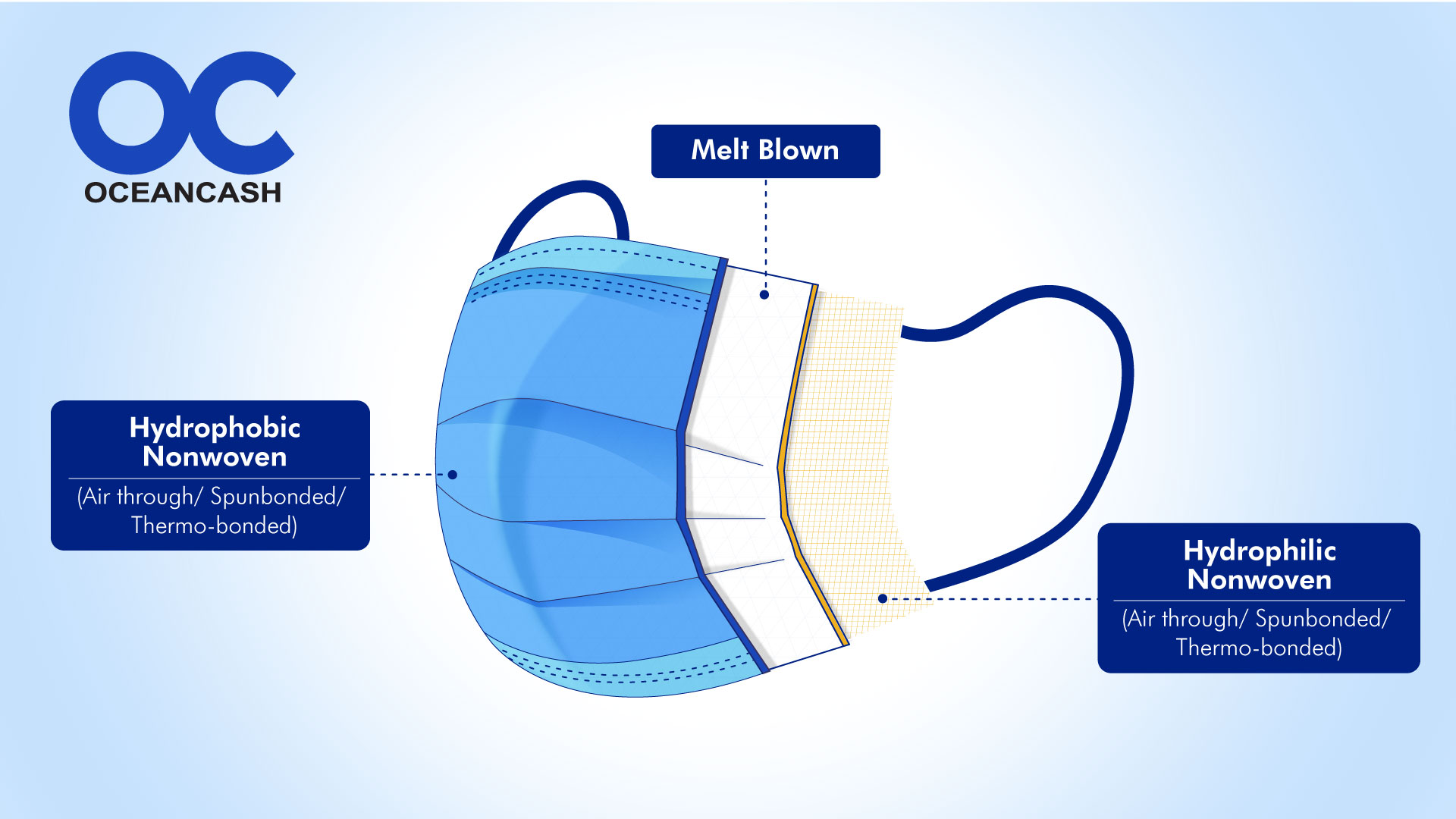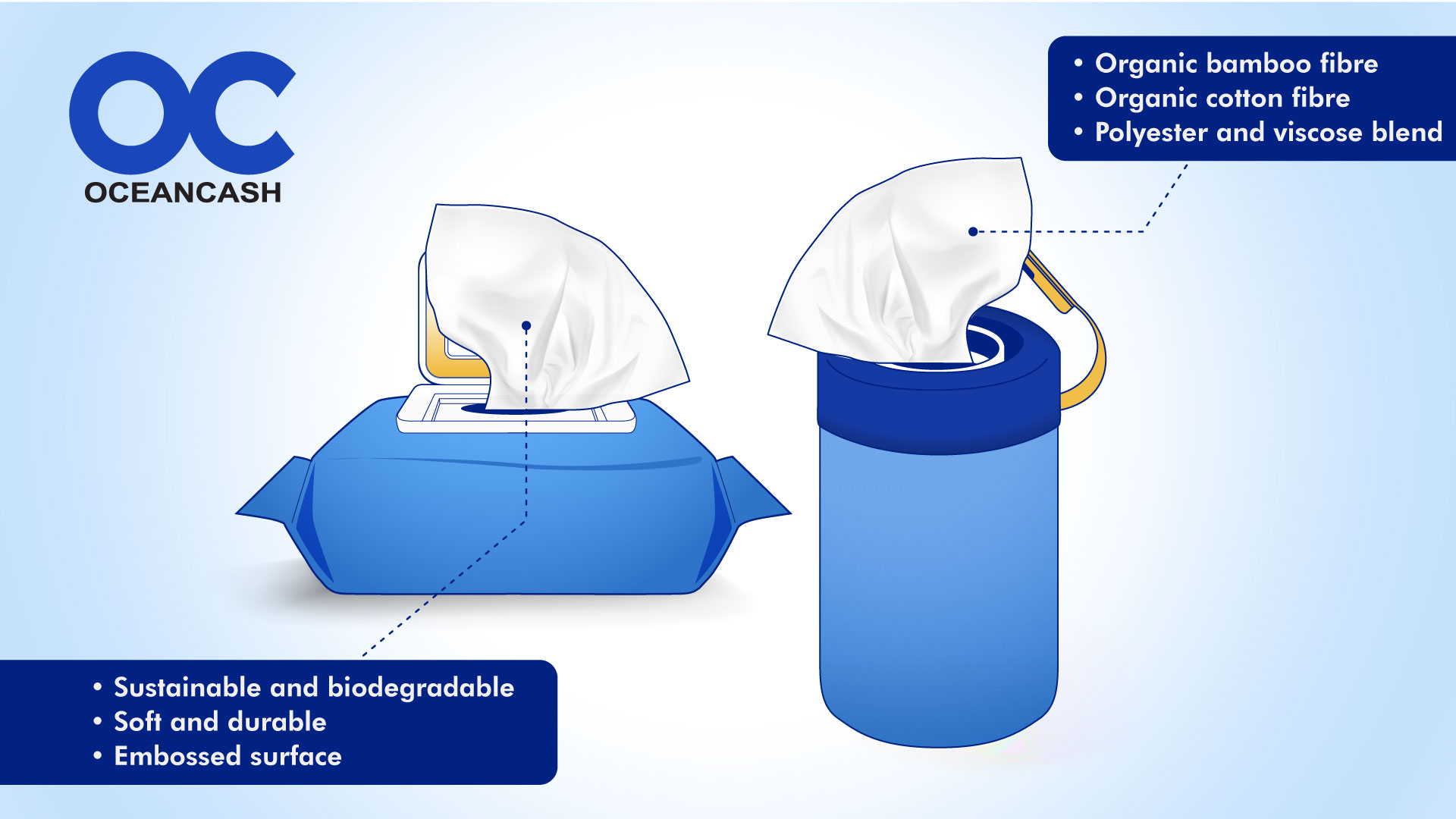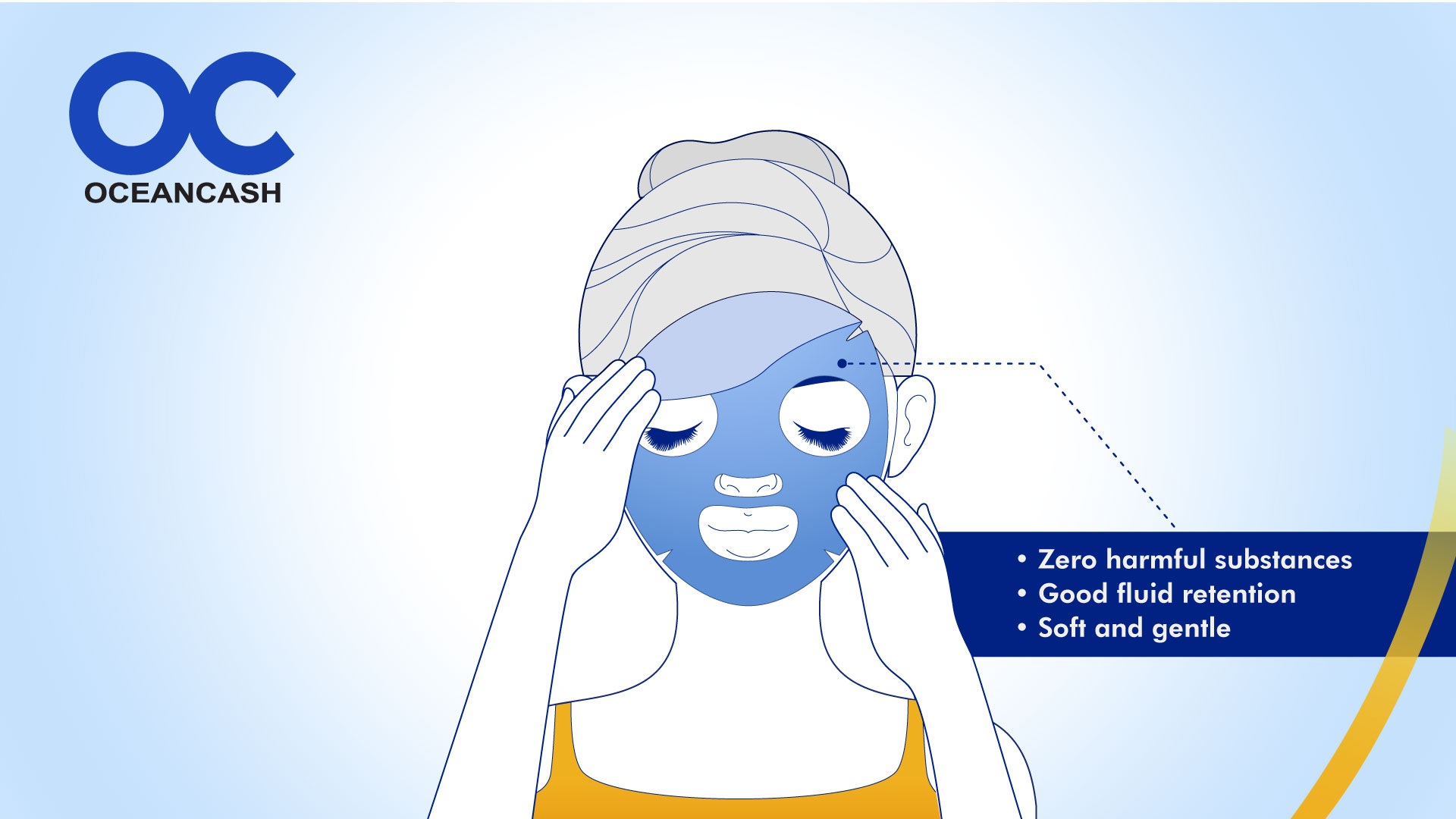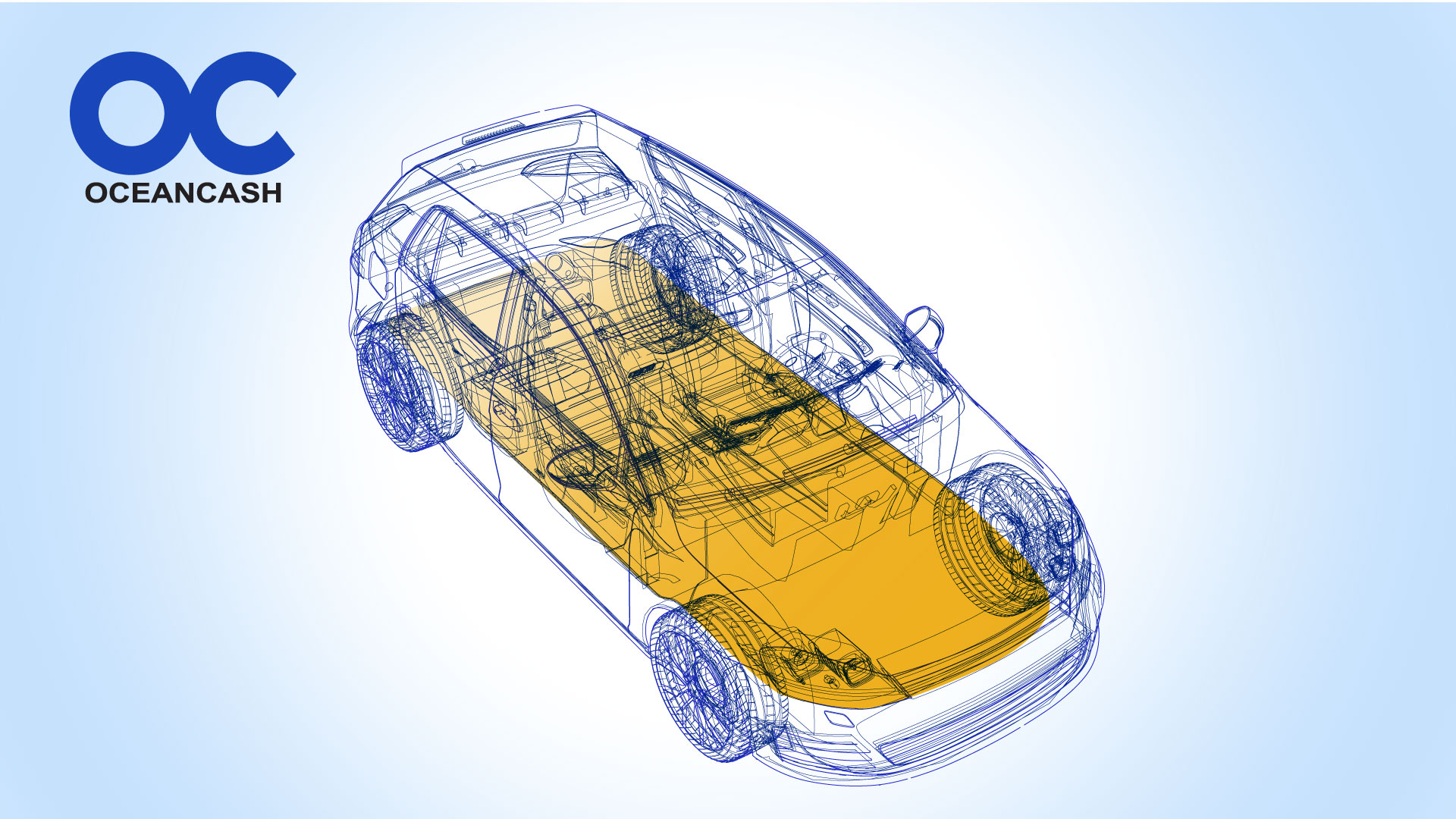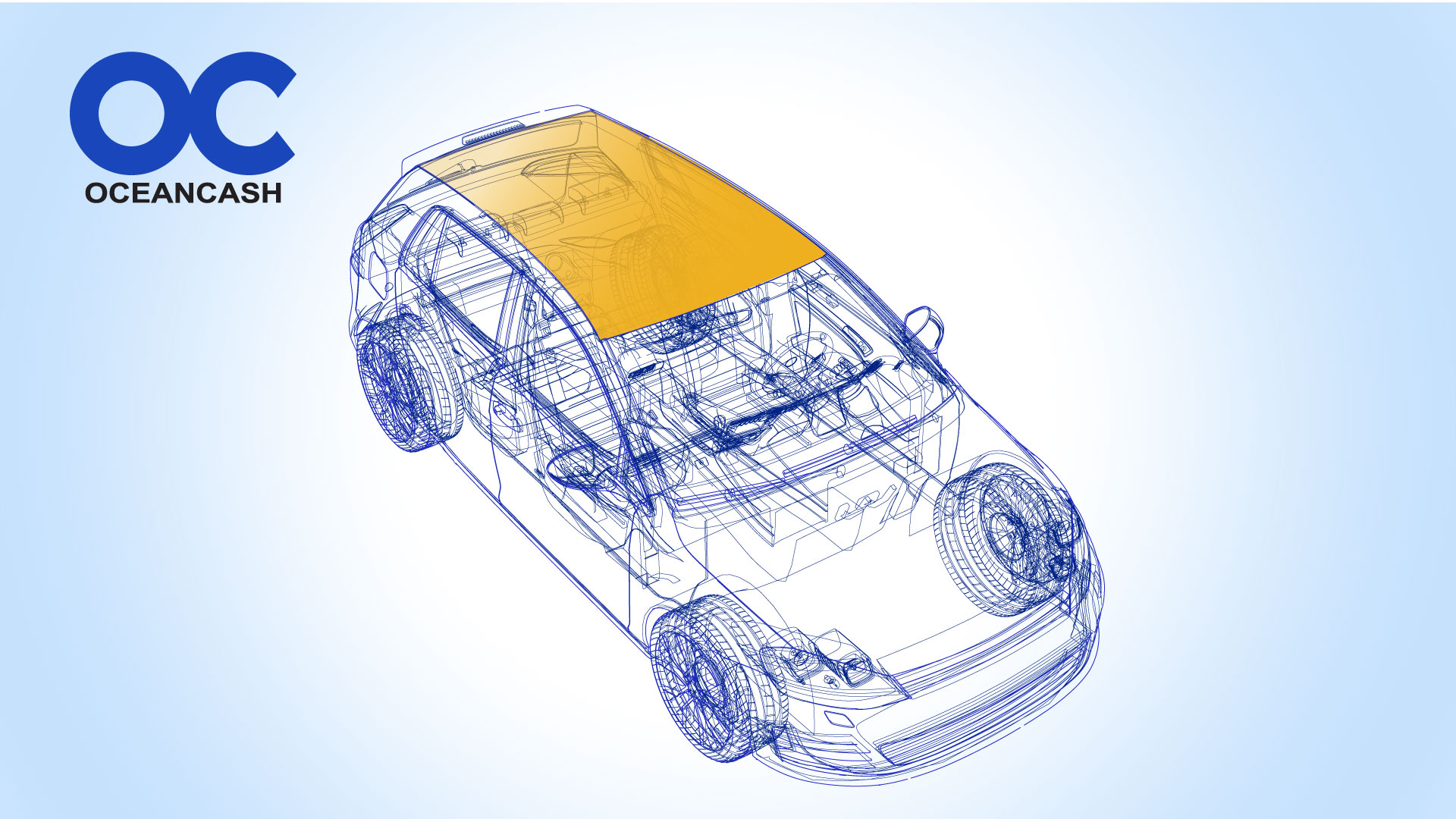
Top Producers of Biodegradable and Spunlace Nonwoven Fabric
At Oceancash, we specialize in creating innovative nonwoven fabric solutions for thriving hygiene markets in Southeast Asia. From baby diapers to surgical apparel, our air-through bonded and Spunlace nonwoven fabrics are the go-to choice for top-sheet, acquisition distribution layer (ADL), and back-sheet materials.
We are committed to using biodegradable materials like bamboo fiber to ensure our products are environmentally safe. Our priority is also to provide soft and gentle materials perfect for even the youngest of a child’s delicate skin. As part of our sustainability efforts, we collaborate with industry associations, NGOs, and stakeholders to promote the use of biodegradable materials and raise awareness about the importance of sustainability in the hygiene industry. We believe that by working together, we can drive positive change and create a more sustainable future for everyone.

What is Nonwoven?
Nonwovens are innovative, high-tech, engineered fabrics made from fibers. Nonwoven fabrics are broadly defined as sheet or web structures bonded together by entangling fiber or filaments (and by perforating films) mechanically, thermally or chemically. In addition to the desirable characteristics provided by this versatile nonwoven material, it has the benefit of being lightweight and safer for the environment.
Application
Nonwoven fabric has become increasingly popular in various industries due to its versatility and unique properties. With its ability to be engineered and customized to meet the specific needs of consumers, nonwoven fabric has found its way into a wide range of applications. As a result, nonwoven fabric can be utilized in countless ways, from healthcare to hygiene products, to enhance performance and efficiency.
Diapers
Femcare
Surgical Mask
Wet Wipes and Dry Wipes
Facial Mask Material
Automotive Spunlace
Spunlace nonwoven materials are revolutionizing the automotive industry by enabling manufacturers to reduce weight, lower costs, and enhance vehicle performance. With their versatility and sustainability, spunlace nonwovens are replacing traditional materials in a variety of applications, offering improved durability, efficiency, and eco-friendliness. Among these, cross-lapped spunlace is particularly valued for headliner applications, delivering superior structural integrity and acoustic benefits. With our in-house spunlace solutions, we provide high-performance acoustic insulation, seat reinforcement, and floor coverings, enhancing both comfort and functionality in modern vehicles.
Technology
Basis Weight: 18g/m2 to 90g/m2
Layered: Single & Dual Layer Structure
Material: Bi-component Polyethylene/Polyethylene Terephthalate (PE/PET), Polyethylene/Polypropylene (PE/PP) Staple Fibre, Viscose, Cotton and Bamboo Fibre
Jumbo Roll Working Width: 2,100mm
Capacity: 12,900 MT/A
Feature: Air-Through bonding and Waterjet (Hydroentangled) bonding
Winding Selection: Pancake Roll & Spool Roll
Slit Width of Nonwoven for Pancake Roll: from 35mm to 2050mm
Pancake Roll Working Width: from 50(35)mm to 2050mm
Slit Width of Nonwoven for Spool Roll: from 35mm to 120mm.
Spool Roll Working Width: from 280mm to 800mm
Hand Feel: Soft, Cottony Soft, Silky Touch, & High Loft
Treatments: Hydrophilic or Hydrophobic
Lustre: White (Dull) or Extra White (Full Dull)
Colour: Blue, Green, Violet, & Black
Specialty: Low pH, Bacterial Control, Cotton (Organic or Bleached) Content, Activated Carbon and Organic Plant Based Fibre.
Design/Patterns: Aperture, Emboss, Laminating & Printing.
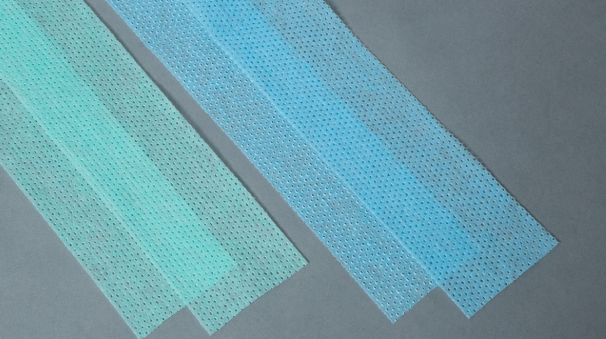
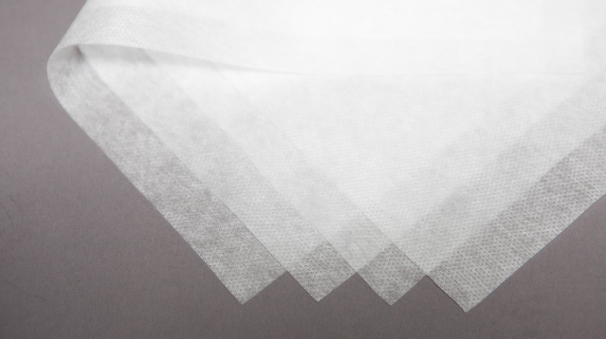
Oceancash Nonwoven Quality Maxim
Remember – The Next Inspector is Our Customer

Quality control
ISO9001 certificate
STANDARD 100 by OEKO-TEX®
STANDARD 100
by OEKO-TEX®
Production Facility
Oceancash Nonwoven Sdn Bhd
Lot 73 Jalan P10/21
Taman Perindustrian Selaman
43650 Bandar Baru Bangi
Selangor Darul Ehsan
Malaysia
FREQUENTLY ASKED QUESTIONS
Spunlace is a nonwoven fabric manufacturing process that involves the entanglement of fibers through mechanical, hydraulic, or water-jet techniques to create a strong and durable material. This method is utilized to produce fabrics with a wide range of properties, making them suitable for various applications across industries such as healthcare, personal care, automotive, and household products.
The production of spunlace fabrics begins with the selection of raw materials, which can include natural fibers like cotton, viscose, and wood pulp or synthetic fibers such as polyester, rayon, and polypropylene. These fibers are initially opened and blended to form a homogeneous fiber web.
The spunlace process involves high-pressure water jets that propel the fibers onto a moving conveyor belt or screen. The fibers are entangled and intertwined through the force of the water jets, creating a cohesive fabric structure. The entanglement of fibers results in a fabric that is strong, tear-resistant, and has excellent tensile strength.
During the entanglement process, the water pressure and the arrangement of the fibers can be adjusted to achieve specific fabric characteristics. The resulting fabric can vary in terms of thickness, density, softness, and absorbency, making spunlace suitable for a diverse array of applications.
One of the key advantages of spunlace fabrics is their exceptional softness, which makes them highly desirable for use in sensitive applications such as baby wipes, facial wipes, and personal care products. The fabric’s gentle texture is often preferred for its comfort and suitability for delicate skin.
Moreover, spunlace fabrics possess excellent absorbent qualities, making them ideal for products like medical dressings, cleaning wipes, and industrial wipes. Their high absorbency allows them to effectively retain liquids, making them efficient for cleaning surfaces or absorbing fluids in medical settings.
In addition to their softness and absorbency, spunlace fabrics can be engineered to exhibit specific properties such as breathability, elasticity, and resistance to chemicals or abrasion, depending on the intended use.
The versatility of spunlace fabrics has led to their widespread adoption in various industries, including the manufacturing of hygiene products, medical supplies, filtration materials, apparel, and household wipes. As technology continues to advance, innovations in the spunlace manufacturing process contribute to the development of new applications and improved fabric characteristics, further expanding its utility across diverse industries.
We specialize in producing Spunlace nonwoven fabric for our hygiene segment, which includes a range of products such as baby diapers, sanitary napkins, wet wipes, and surgical apparel such as caps, masks, and gowns. Spunlace nonwoven fabric, or hydroentangled fabric, is a unique type of nonwoven material composed of fibres entangled together using high-pressure water jets.
During production, high-pressure water jets are directed at a web of fibres, interlocking and entangling fibers to create a cohesive and durable cloth. This manufacturing method creates a final product that is soft, absorbent, and long-lasting, with a texture similar to woven fabrics. Spunlace nonwoven fabric can be produced from various materials, including natural fibers such as cotton or wool, synthetic fibers like polyester or nylon, or a combination.
One of the main advantages of our Spunlace nonwoven fabric is that it is made from natural fibers, meaning it is biodegradable and safer for the environment. Additionally, our fabric is lightweight, making it more sustainable and environmentally friendly. With our commitment to producing high-quality, sustainable products, we are proud to offer Spunlace nonwoven fabrics that meet customer needs across the hygiene industry.
Organic cotton is classified as a type of cotton that doesn’t come from genetically modified plants that use pesticides, insecticides, and other toxic chemicals. Due to this, cotton organic is environmentally friendly. The standard cotton that is generally used is defined as conventional cotton. The good news is that Oceancash nonwoven is made with organic cotton material, keeping you safe from toxic chemicals that are usually embedded in conventional cotton.
The benefits of using certified organic cotton material are numerous. Compared with conventional cotton, it is softer and more pleasant; therefore, it is perfect for those with sensitive skin or allergies.
Over time, organic cotton proves to be a more advantageous investment due to its superior durability and longer lifespan compared to conventional cotton. Furthermore, because organic cotton breathes well, it’s a great material for sportswear and for those who need to wear comfortable, breathable clothes to work.
Because of its easy biodegradability and compostability, it doesn’t leave any harmful waste, thus having a positive impact on the environment. This is particularly crucial when you take into account the volume of textiles and apparel that are disposed of in landfills every year. You may be certain that you are lessening your carbon footprint and maintaining a clean and healthy environment by selecting raw materials made of organic cotton.
Lastly, buying organic cotton helps to assist regional farmers and rural areas. By purchasing goods made of organic cotton, you are assisting the local economy and farmers, who put forth a lot of effort to produce sustainable, healthful goods.
If you’re looking for organic cotton nonwoven fabrics, you’ve come to the right place.
According to the most recent report by Textile Exchange for 2020/21, their estimations show that 342,265 metric tons of organic cotton fiber were produced on 621,691 hectares of certified organic land in the 2020–21 global harvest, while 180,726 metric tons of fiber from in-conversion were produced on 293,204 hectares of land that was converted to organic. This indicates a projected 37% increase in organic fiber from 2019–20. With 24,380,507 metric tons of cotton produced overall in 2020–21, according to the ICAC, 1.4% of all cotton grown is thought to have been organic.
A nonwoven fabric is a textile made by bonding fibers together mechanically, thermally, or chemically rather than weaving them like traditional fabrics. As the name suggests, biodegradable nonwovens are nonwoven fabrics that break down naturally in the environment without leaving harmful residues.
These fabrics are typically manufactured using natural materials like cotton, wool, or bamboo, or synthetic materials such as polylactic acid (PLA) or polyhydroxyalkanoates (PHAs). They have various applications in packaging, agriculture, horticulture, hygiene products, and other industries.
The use of biodegradable nonwoven materials in hygiene products, for instance, is a more environmentally friendly option compared to traditional nonwoven fabrics that are often made from synthetic materials, which can take years to decompose in the environment. By utilizing biodegradable materials, these fabrics can help reduce the amount of waste in landfills or pollute the ecosystem. Additionally, they can contribute to a more sustainable future for our planet.
Plant-based fibers are natural fibers derived from various plant sources. They are widely used in the textile industry to manufacture fabrics and textiles for different applications, including clothing, home furnishings, and industrial products. The most commonly used plant-based fibers include cotton, linen, hemp, jute, bamboo, and sisal.
For instance, Oceancash’s wet wipes are made from a combination of polyester and organic bamboo fiber, a fast-growing and eco-friendly plant-based fiber derived from the bamboo plant. Bamboo fiber is well-known for its softness, breathability, and moisture-wicking properties, so it’s a popular choice in clothing and bedding. Additionally, bamboo is an incredibly sustainable fabric because it uses less water and pesticides than cotton.
When added to Spunlace material, plant-based fibers can help retain moisture for an extended period, ensuring thorough cleaning and enhanced comfort for your loved ones. In addition, by incorporating plant-based fibers into our products, we can provide our customers with high-quality, sustainable materials that offer both superior performance and environmental benefits.




